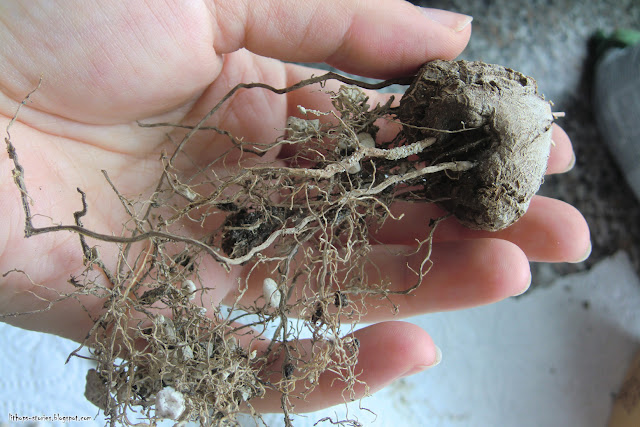If you happen to follow me on Twitter you're already aware of and hopefully not too annoyed by my current obsession with caudiciforms. Same as with Adromischus last year and Anacampseros/Avonia the year before that, my interests shift and develop and inevitably include a new genus or type of plant to obsess about each year. It does not mean I'm neglecting any of my earlier passions. Those passions are very much alive and growing. But discovering new plants for oneself, as you surely know, is a special delight. From what I see within our plant growing community, my fascination with caudiciforms of all kinds was long time coming and could even be considered a natural progression of sorts. And yes, it probably means Haworthias are next! 😄
Before going on a shopping spree I did consider accommodations for the new plants. A corner in front of the balcony was not being used sufficiently, even though it is a really bright spot with lots of morning sunlight and ceiling-high windowpanes for vines to enjoy. I have also cleaned milk glass films from two panes to enable plants be placed floor level. And yet, it seems I have underestimated how large the leaves and vines can get! Luckily not all of the fat plants grow at the same time. I still have some wish plants in mind that I would like to get, but the collecting is practically over and the growing begins. The exciting part!
Here is the general setup, with some other plants strategically placed on windowsills.
You see those ginormous vines and heart shaped leaves? That's a Stephania (most likely rotundifolia or cephalantha). Got this one at the Essen succulent market some time ago after another Stephania species (the one with round leaves, S. erecta I believe) was snatched away from under my nose (this year's market was brutal!). The second choice has quickly become the main attraction.
So much green and it's growing visibly every day. I swear I saw it move in front of my eyes one morning! I'm not used to this speed of growth with all those mesembs and co. She needs a lot of water to support all this, too. But these leaves are worth every effort.
Next are the two Cucurbitaceae (pumpkins) I got from the same place. Both for some reason have abandoned all vines except one, which then proceeded to grow until it reached the ceiling. They are still trying to continue growing, somewhere, somehow.
The leaves are very similar. Left is Cyclantheropsis parviflora, right - Momordica boivinii.
The caudex shape is quite different though. Momordica boivinii is still rather young but from what I understand the caudex will be something of a tree trunk.
It has been flowering, too, showing male as well as female flowers. The timing was not right for any pollination attempts.
Cyclantheropsis parviflora's caudex is flat with really nice bark. Honestly, bark of caudiciforms is so fascinating. Especially the way it splits and peels and then splits again when the caudex grows.
The whole thing with bark cracking when growing is of course most prominent in certain Dioscorea species. I have a couple of young Dioscorea elephantipes, while I'm not 100% sure the bigger plant is D. elephantipes. The smaller plant is just waking up.
The bigger one is actively growing and showing great climbing skills, too. Clever plant does not inflate its leaves until it gets a good grip somewhere.
By the way, if you thought these are ball shaped underneath, the shape is more of a jelly fish.
I do have a big 30 cm Dioscorea, but it's a Dioscorea macrostachya (syn. mexicana) and being a summer grower it's dormant now. Hope it will wake up in March or so... It is alive and rooted. Fingers crossed.
That's no moon! It's a..... Raphionacme burkei.
Very cool plant. Hope not to kill it.
It seems to be growing flowers at the moment, followed by leaves. It is supposed to be a shrub which is good because the Stephania is gonna take over the whole climbing trellis anyway.
If you thought this one is round underneath - nope! It's a turnip.
Love the bark/leaf color contrast.
And no, it's not ball shaped. I don't even know what this is. A monster carrot?



























I've always loved seeing your beautiful succulents, but your home is beautiful as well! What great light you receive.
ReplyDeleteThank you so much :)
DeleteMy apartment, especially the living room with most of the plants, is indeed full of light. Provided the sun is shining here in Germany ;)
Hallo, can you help me, please? I have bought my first Stephania rotundifolia and I don´t know, how to care of it during winter. I can not find a lot of informations about it. Now, I have it in cca 10 degrees of Celsius, no water, less light (the plant have now any leaves, only the bulb).
ReplyDeleteMany thanks! Alena